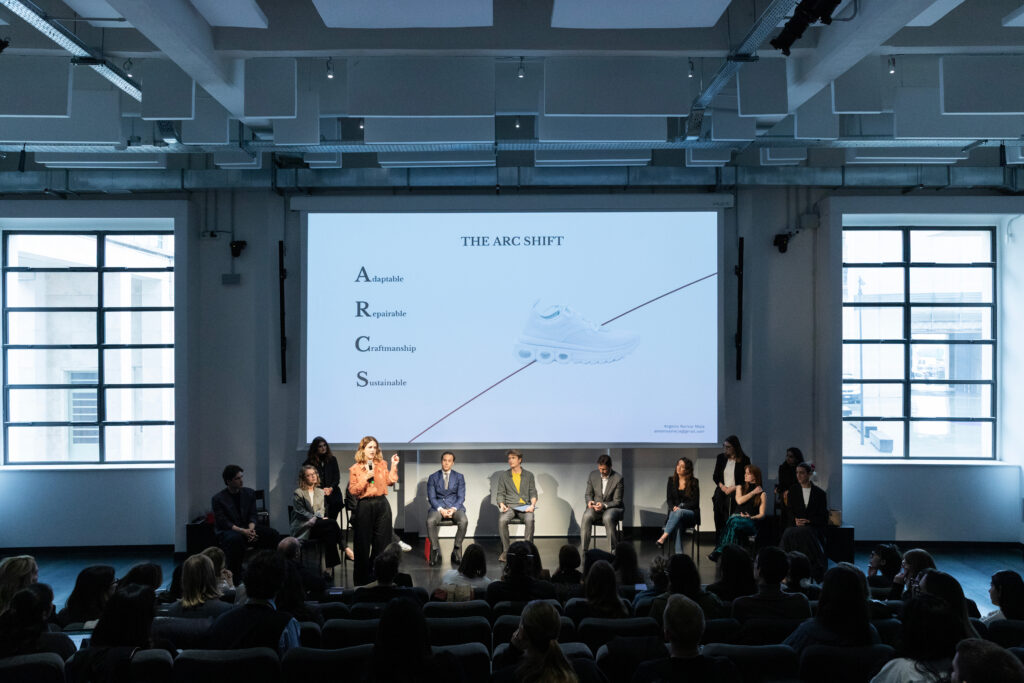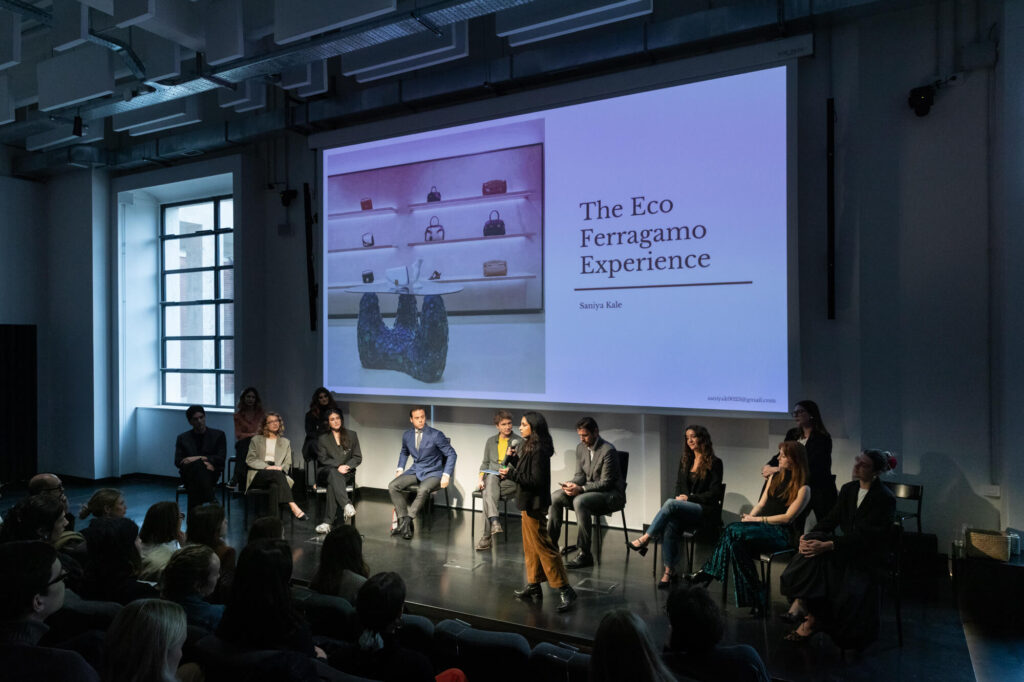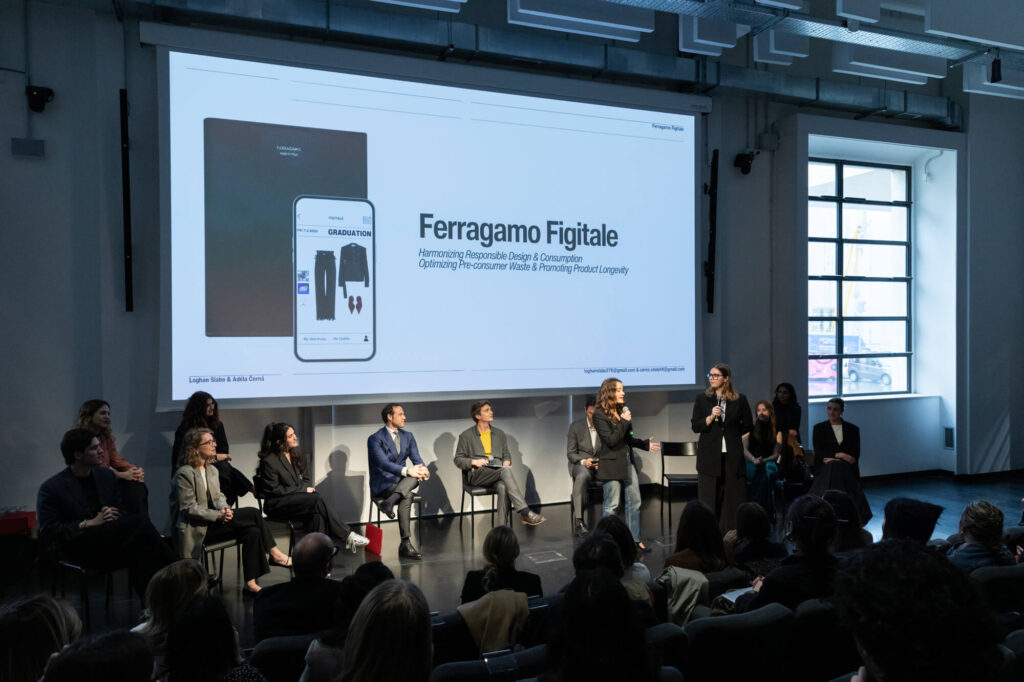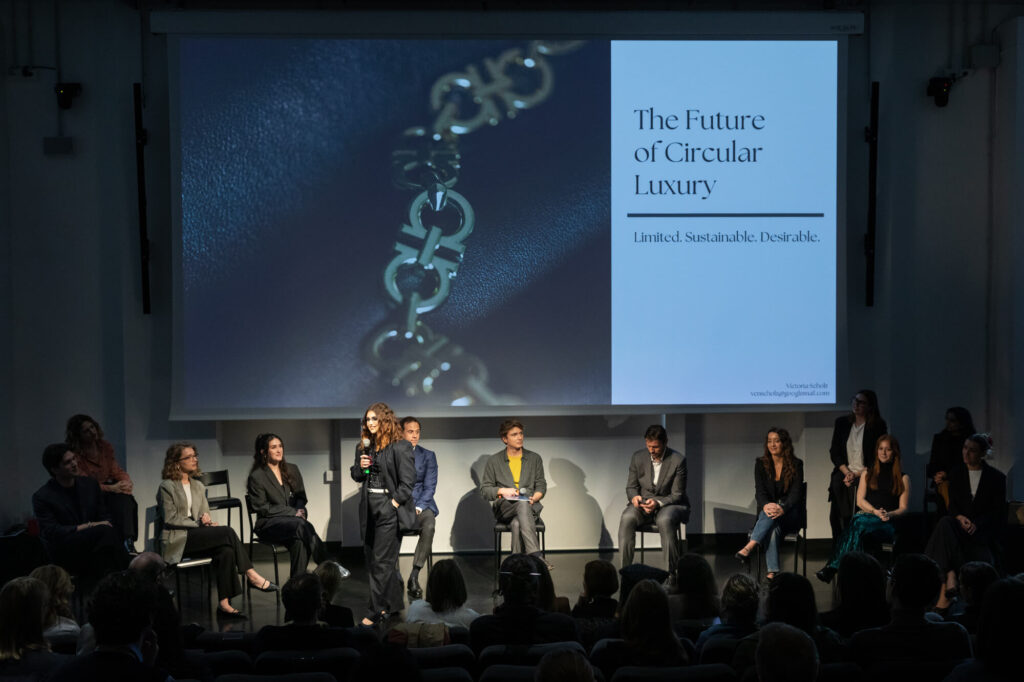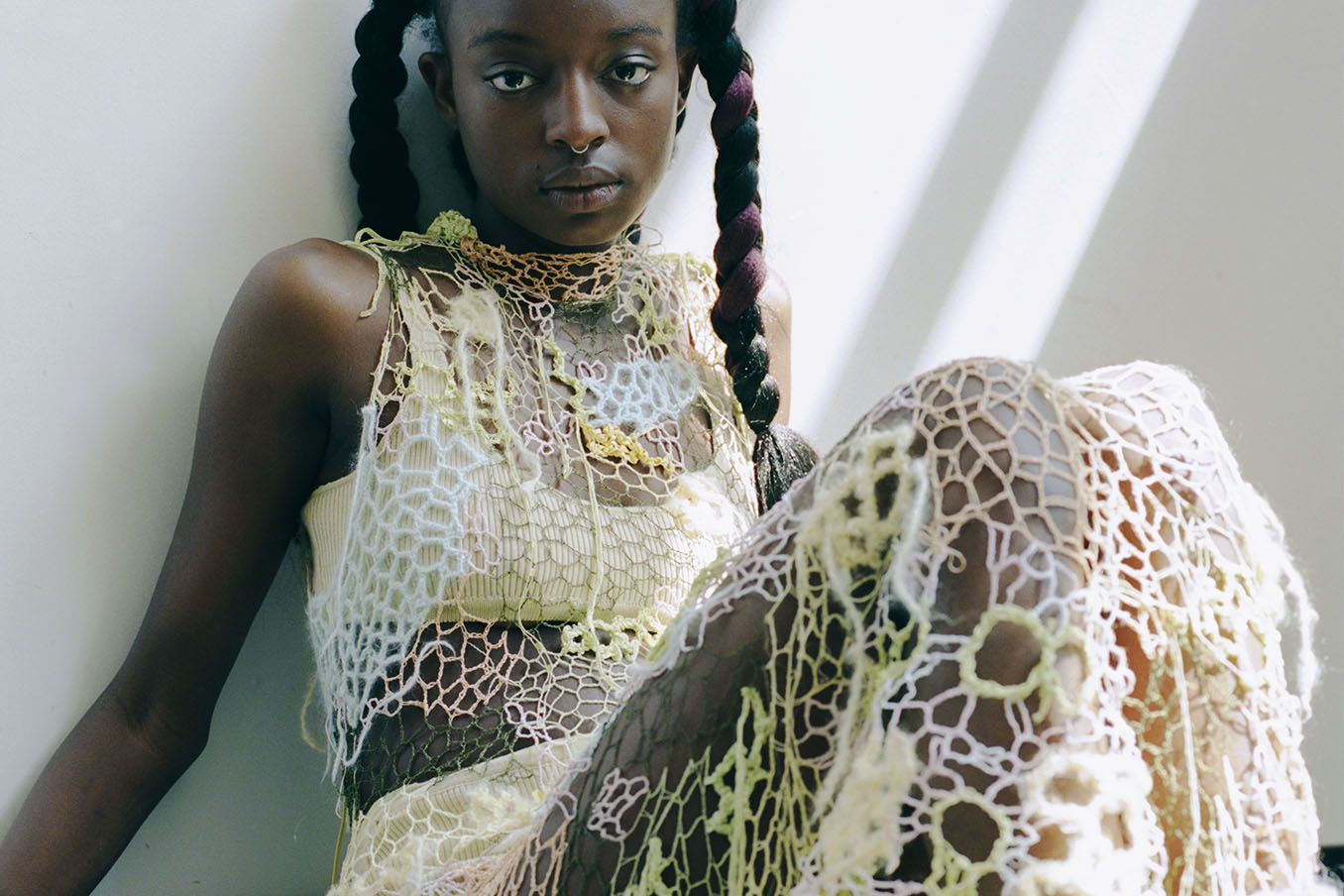In an industry grappling with crises, Ferragamo stands out not only by relying on conventional market analysis but, more importantly, by embracing the energy and creativity of those truly driving change: Gen Z and Millennial students.
During the Design, Think, Change talk, held on 12 March at the Aula Magna of Polimoda’s Manifattura Campus, Matteo Ward, co-founder of WRÅD and CEO of Inside Out Fashion Textiles & Home, moderated a discussion on innovation and sustainability. He was joined by James Ferragamo, Chief Product Officer of the Ferragamo Group, Davide Triacca, Sustainability Director at Ferragamo, and ten international students from Polimoda’s Master in Sustainable Fashion.
The talk presented the results of an ambitious research project developed by students in collaboration with Ferragamo. It introduced the concept of an interdisciplinary innovation hub designed to integrate industrial-scale experimentation, circular economy solutions, and digital technologies into a new, responsible business model for fashion brands. The proposals—ranging from modular upcycling solutions and waste reduction strategies to sustainable water resource management and consumer education through AI and virtual reality—demonstrate how the synergy between artisanal heritage and technological innovation can radically transform the fashion system.
By acting as a catalyst for new ideas and supporting the next generation directly, Ferragamo reaffirms its role as a key driver of change towards a more conscious and sustainable luxury industry.
The project
Reimagining an icon for the new millennium while preserving its intangible heritage and timeless innovation: this is the challenge taken on by students of the Master in Sustainable Fashion. Inspired by Ferragamo’s visionary approach and commitment to values, craftsmanship, and attention to detail, they have developed a portfolio of forward-thinking, responsible ideas. Their proposals range from innovation hubs and sustainable water management to modular and circular footwear design and new sensory experiences in flagship stores, enhanced by technology.
The project was shaped by in-depth research into the historical Archive and Museum of Salvatore Ferragamo,followed by an analysis of the maison’s operational processes, from design to production and distribution. By applying design thinking methodologies and systemic analysis, these studies have led to concrete proposals that offer a pathway to a more ethical and innovative future for fashion.
Beyond promoting sustainability, Design, Think, Change aims to foster intergenerational dialogue and highlight the talent and vision of emerging creatives. Through this initiative, the perspectives of Gen Z and Millennials are actively integrated into discussions with established companies and industry leaders, contributing to reshaping the future of fashion with a sustainable outlook.
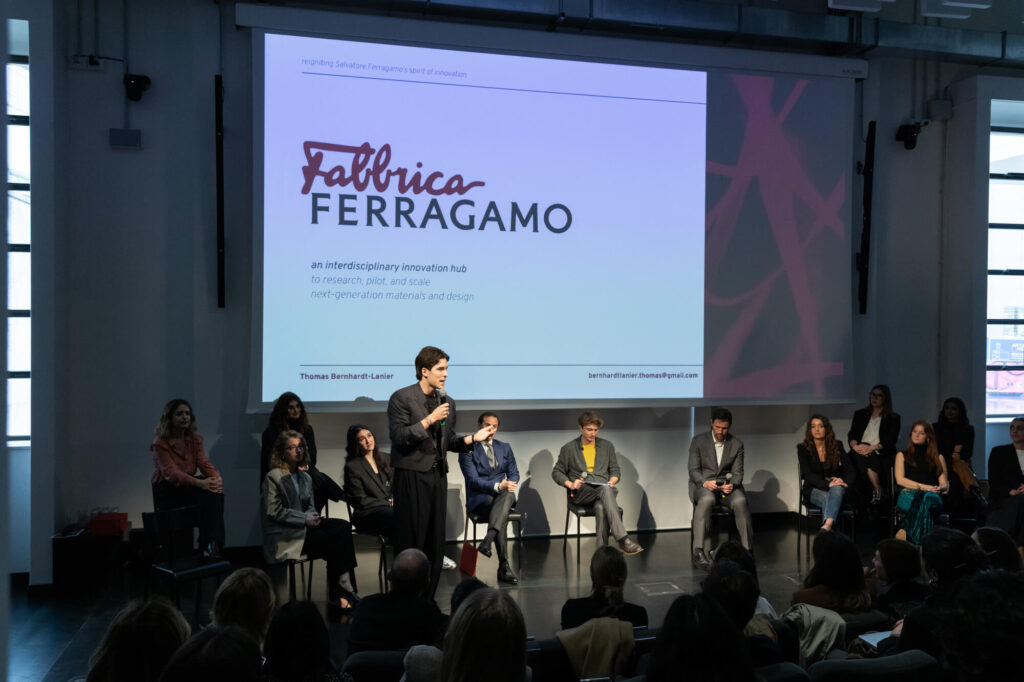
An interdisciplinary innovation hub
The students’ research project envisions the creation of an interdisciplinary and collaborative innovation hub— Fabbrica Ferragamo, presented by Thomas Bernhardt—that redefines the fashion system through industrial-scale experimentation with sustainable materials and design. Inspired by the legacy of master artisans, this hub turns economic and environmental challenges into opportunities for renewal, merging innovation, cross-sector collaborations, and direct consumer engagement to foster responsible luxury.
Findings from the research underscore that investing in the experimentation of innovative raw materials and eco-friendly production processes is fundamental for achieving a transformative shift in the industry. Not only does this reduce environmental impact, but it also enables the development of high-performance, aesthetically compelling products. The use of recycled, biodegradable, or technologically advanced materials is a key lever in redefining product lifecycles.
The project emphasises the need for a holistic approach to sustainability: isolated solutions are not enough; the entire production system must be rethought, from design to post-consumption. Cross-sector collaborations play a crucial role: synergies between universities, research centres, start-ups, NGOs, and brands generate integrated and innovative solutions, fostering knowledge exchange and multidisciplinary approaches essential for overcoming environmental and social challenges throughout the fashion supply chain.
Innovative solutions
Students presented a range of solutions, integrated within a single hub of innovation and experimentation, to create a sustainable ecosystem where artisanal tradition, modern production processes, and digital technologies converge to promote a circular and responsible business model.
The first proposal focuses on sustainable water resource management, a global concern with particular relevance to Tuscany, where the tanning and leather goods industries highlight the urgent need for targeted interventions. The research identified innovative solutions for optimizing water use in production, employing recycling technologies and monitoring systems to enhance efficiency and minimize waste. This approach promotes greater awareness and responsibility, extending from brands to raw material suppliers. The WaterWise Accelerator, designed by Katelyn Kelley and Mhari Reid, aims to drive innovation in water management across the fashion supply chain, offering a holistic strategy that positions Ferragamo as a leader in responsible resource management.
The circular economy model emerged as a winning strategy for the fashion system. Redesigning garments and accessories to facilitate repairs, updates, and material recovery represents an exciting challenge for the industry. Angie Ramos’ research—based on the pioneering high-end sneaker model The ARC Shift Project—demonstrates how circularity, integrated into design through modular solutions, can replace the traditional ‘disposable’ model with one that values reuse and renewal.
Retail experiences are also evolving: the integration of immersive and interactive experiences in stores, through smart mirrors and gamification, presents an effective way to educate consumers and guide them towards more conscious choices. These solutions transform traditional retail spaces into dynamic environments where digital and physical experiences merge to enhance the customer journey. Sustainability & Luxury: Bridging the Gap by Saniya Kale envisions a retail experience powered by AI to educate consumers on sustainable materials, ethical craftsmanship, and responsible consumption, embedding the concept of sustainable luxury into the shopping experience.
Another key finding is the integration of digital and physical experiences. Students observed that technologies such as NFC chips, wardrobe management apps, and AI-driven solutions can create a connected and personalized user experience. These tools enable consumers to track product conditions, receive care and reuse suggestions, and maintain an ongoing dialogue with brands, extending product lifespan and strengthening brand affinity. Ferragamo Figitale by Loghan Slabe & Adela Cerna proposes a line of refillable cover agendas made from recycled textile paper, paired with an app designed to promote wardrobe longevity through AI-powered recommendations.
The research also explored upcycling and deadstock recovery as innovative practices for reducing waste. Transforming unsold materials and production scraps into high-quality new products not only reduces environmental costs but also enhances the storytelling and qualitative value of items, giving them a second life. The Ferragamo Circular Pop-Up, proposed by Victoria Scholz, leverages Ferragamo’s deadstock materials to create limited-edition collections sold through pop-up stores in prestigious global locations, adopting a circular approach that includes repairs and traceability.
The project also highlighted the opportunity to educate customers on sustainability through accessible luxury products as an entry point. The adoption of refillable packaging and the use of locally sourced, organic ingredients selected according to sustainability criteria respond to a growing demand for transparency and accountability, enhancing local heritage while reinforcing consumer trust. Essence by Ferragamo, developed by Kate Kawelek and Mia Van Der Nest, introduces the concept of a responsible fragrance, crafted with locally sourced organic raw materials and a refillable bottle, designed to protect the environment and safeguard consumer well-being.
Comments
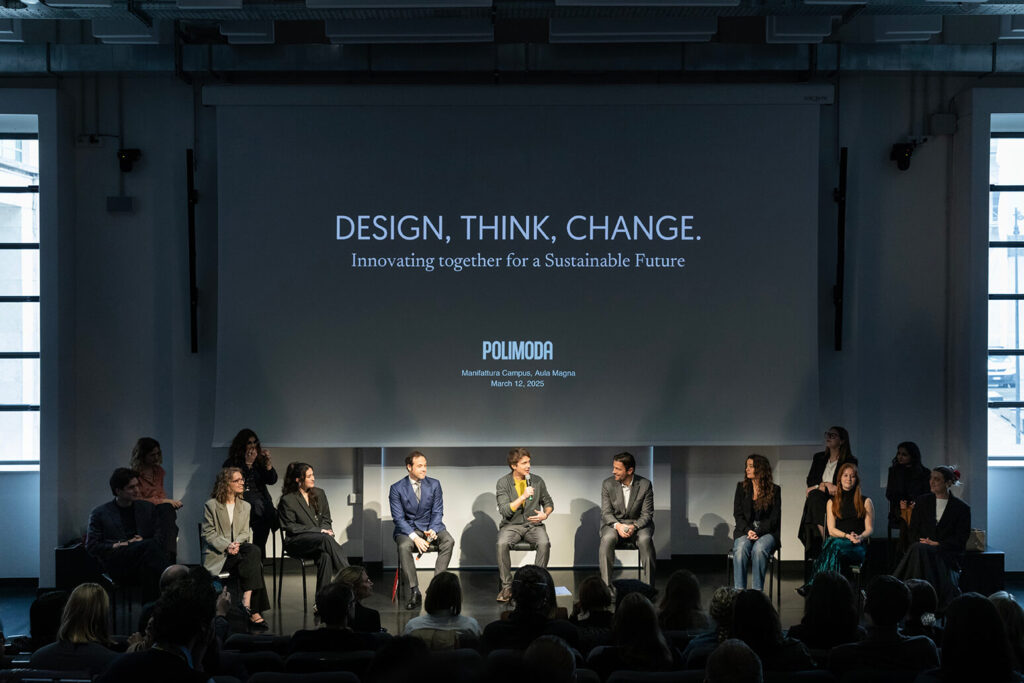
“Design, Think, Change aims to inspire a new approach to design. Design thinking is inherently exploratory, iterative, and non-linear. It does not follow a binary logic of right or wrong and is not solely about finding a solution to a problem. Instead, it continuously questions and refines our assumptions, rather than rigidly adhering to an initial plan .” – Matteo Ward.
“We are proud to collaborate with Polimoda and Matteo Ward on a project that combines our artisanal heritage with the fresh, innovative outlook of the new generation. Design, Think, Change is an extraordinary opportunity to inspire a sustainable future for fashion through the creativity and pioneering ideas of Polimoda’s Master in Sustainable Fashion students. This initiative allows us to merge tradition and innovation, redefining the future of fashion with a sustainable and responsible vision .” – James Ferragamo.
“Our generation seeks to drive a radical transformation in how fashion approaches sustainability, focusing on action and accountability. We advocate for a holistic approach: sustainability is not just about creating responsible products but also pushing brands to go beyond the product, tackling the social and cultural disparities that demand urgent change. This perspective not only generates tangible impact but also fosters trust and loyalty towards brands that genuinely commit to change .” – Katelyn Kelley, one of the students involved in the project.
Ferragamo: between tradition and transformation
With nearly 100 years of history, Ferragamo is a symbol of Italian excellence. The brand preserves a unique heritage within its archives, serving as both a foundation and an inspiration for new creative directions. Sustainability is deeply embedded in Ferragamo’s strategy, with the company annually implementing a Sustainability Plan focused on reducing carbon emissions, innovating materials—particularly in leather—ensuring a responsible value chain, empowering its people, and creating shared value for communities. Through collaboration with Polimoda students, Ferragamo seeks to merge heritage and innovation, uncovering new insights aligned with its long-term sustainability goal.

Design, Think, Change: Ferragamo and Polimoda, Innovating together for a Sustainable Future
Photo credits: Serena Gallorini

